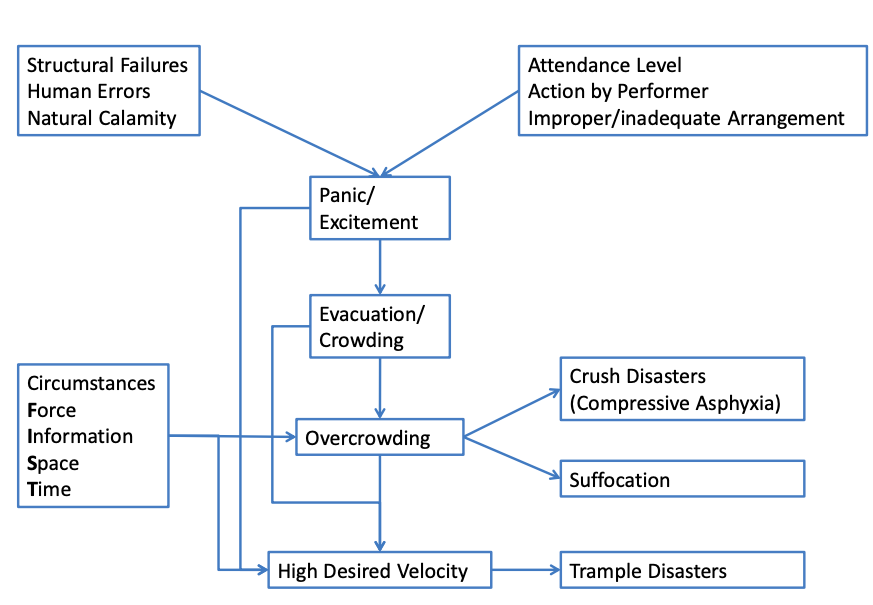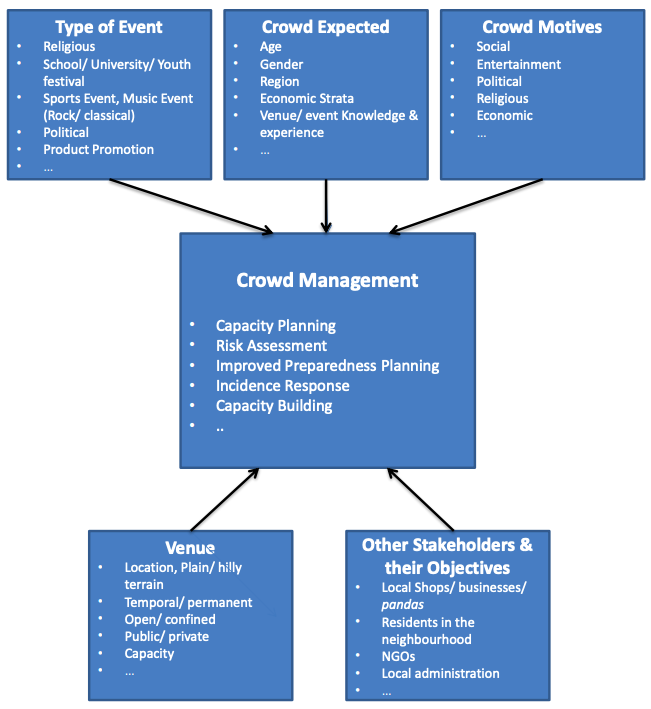ForumIAS announcing GS Foundation Program for UPSC CSE 2025-26 from 19 April. Click Here for more information.
Contents
| For 7PM Editorial Archives click HERE → |
Introduction
A series of crowd disaster incidents have led to deaths of more than 400 people recently. On October 01, 2022, a human crush occurred in a football stadium in East Java, Indonesia that killed 135 people. On October 29, 2022, a crowd crush occurred during Halloween festivities in Seoul, South Korea that killed more than 150 people and injured another 170+ people. On October 30, 2022, a bridge collapse due to overcrowding led to deaths of more than 135 people. Although the dynamics of each of these three scenarios were diverse, experts agree that inadequate planning and management of crowds led to the calamities that occurred. In context of India, the National Disaster Management Authority has issued guidelines (NDMA Guidelines) for managing crowd at venues of mass gathering and avoiding crowd disasters.
What are the causes behind Crowd Disasters?
Broadly, the causes behind crowd related disasters have been categorised into 6 categories.
Structural: This includes: (a) Structural collapse of makeshift bridges, railings, temporary structures etc.; (b) Improper and unauthorised structures; (c) Railings of the bridge collapse due to panic triggered by rumours; (d) Difficult terrain (famous religious sites built on top of hills that are difficult to access); (e) Narrow streets with very few entry/exits; (f) Absence of emergency exits etc.
Fire/Electricity: This includes: (a) Fire in a makeshift facility or a shop; (b) Fire at illegal and unauthorised structure; (c) Wooden structure/ quick burning acrylic catching fire; (d) Non-availability of fire extinguishers in working condition; (e) Building and fire code violations; (f) Unauthorized fireworks in enclosed places; (g) Electricity supply failure creating panic and triggering a sudden exodus; (h) Illegal electric connections; (i) Faulty electric equipment etc.
Crowd Control: This includes: (a) More than anticipated crowd at store/mall/political rallies/ examinations/ religious gatherings/ public celebrations; (b) Underestimation of audience, staffing, services; (c) Closed/locked exit, Sudden opening of entry door, Reliance on one major exit route; (d) Lack of adequate and strong railings to marshal the queue; (e) Lack of proper public address system to control the crowd etc.
Crowd Behaviour: This includes: (a) A wild rush to force the way towards entrance/exits; (b) Crowds forcing to entrance/exits a venue after the start/closing time; (c) Rush during distribution of disaster relief supplies; (d) Free distribution of gifts/goods triggering a surge and crush; (e) A large (much more than expected) anxious and competitive crowd gathering at promotional events; (f) Unruly and irresponsible crowd behaviour; (g) Last minute change in platform for train arrival/departure resulting in lots of movements within short period of time etc.
Security: This includes: (a) Security Personnel: (i) Under deployment of security staff and deployment of untrained staff; (ii) Lack of adequate rehearsals and briefing of security personnel on crowd control; (iii) Lack of adequate scientific planning in making police arrangement to deal with crowd with proper sectoral deployment; (iv) Lack of proper wireless deployment; (v) Ineptitude of the police in effectively managing the crowd and enforcing prohibitory orders; (b) Surveillance: (i) Lack of adequate observation towers with proper wireless communication to monitor and regulate crowd; (ii) Lack of adequate CCTV surveillance of the crowd; (iii) Absence of public announcement systems or effective wireless system with the police; (c) Infrastructure: (i) Lack of adequate road opening parties to secure the routes; (ii) Lack of adequate metal detectors and frisking of pilgrims entering the pilgrimage area or persons entering the gathering area etc.
Lack of Coordination between Stakeholders: (a) Coordination gap between agencies (e.g. Police and District Magistrate; PWD, Fire Service, Forest officials, Revenue officials, Medical officers etc.); (b) Poor infrastructure (Plans on paper but no implementation due to lack of funds, resources, or will); (c) Inadequate water, medical assistance, public transport/parking facilities; (d) Communication delays; (e) Vacant/late/delayed posting of key personnel etc.
Source: NDMA. Crowd Disaster Process
What are the NDMA Guidelines to manage Crowd Disasters?
The NDMA has issued guidelines for Managing Crowd at Events and Venues of Mass Gathering based on integrated approach for crowd management.
Source: NDMA. Integrated Approach to Crowd Management
Planning for Crowd Management Strategy and Arrangements
This includes
Understanding venue, visitors and stakeholders: The basic element for event planning and crowd management is understanding the venue, visitors and different stakeholders. It requires understanding of type of event (religious, youth festival, school/university event, cricket/sports event, music concerts, political gathering), season, the venue (temporal/permanent, open/confined spaces, plain/hilly terrain), type of crowd expected (age, gender, region, locals/visitors, people with special needs etc.), motives of various visitors (social, entertainment, political, religious, economic etc.) and unwanted visitors (theft, disruption, terror etc.).
Crowd Management Strategies: The various elements of crowd management strategy are: (a) Capacity Planning (long term and short term); (b) Understanding Crowd Behaviour; (c) Crowd Control; (d) Stakeholder approach.
Capacity planning includes a long term perspective for infrastructure development e.g., provision of adequate facilities based on popularity and expected crowd at the events. Facilities should also include crowd monitoring and management infrastructure.
Individual behaviour in a crowd is sometimes influenced by the behaviour of others. Research has shown that understanding of crowd behaviour has led to community based approach to crowd control instead of force based control. The unlawful actions of a few people can result in larger numbers following them. Action should be taken immediately with tact and firmness, without inviting undue attention from the general public. Special attention should also be given to border of the venue and the floating crowd moving there because the mischief is usually caused at such places.
The guiding principle for crowd control should be managing demand – supply gap through (a) Controlling the crowd inflow; (b) Regulating the crowd at the venue (e.g., Barricade facilities to control the movement of crowd, Snake line approach etc.); (c) Controlling the outflow, if needed
Organizers, Law enforcement agencies must rethink crowd control and encourage community stakeholders (NGOs, Business Associations, Schools/ colleges, Neighbourhood societies/associations) to take ownership in events for unity of purpose, faster decisions/response, better coordination etc. A Unified Control Structure is recommended.
Risk Analysis and Preparedness: This includes identification of threats, assessment of risks, planning and developing appropriate course of action.
Information Management and Dissemination: In the absence of necessary information, people may panic leading to undesirable behaviour. Appropriate information and its dissemination is a useful tool in managing crowds. Communicating with visitors and providing them with the correct information is a very critical factor in all situations. Timely information exchange between various stakeholders viz. event management, government administration, security agencies, NGOs, media, and local population etc. can ensure that crowd gathering events run smoothly and successfully without any untoward incidents. This includes (a) Proper briefing by the organizers; (b) Police, Fire, Ambulance numbers; (c) Event route maps with entry/exit points; (d) Dos and don’ts to ensure smooth movement of crowd ; (e) Proper signages etc.
Safety and Security Measures: The organisers should ensure authorised use of electricity, fire safety extinguishers and other arrangements as per the safety guidelines. Use of CCTV cameras and UAVs to monitor crowds can prevent stampede incidents. Guidelines related to fire electrical safety (like adherence to fire standards) should be ensured.
Facilities and Emergency Medical Services: The need is to ensure availability of trained first-aid staff, kits, adequate stretches, emergency life saving medicines and devices, ambulances, mobile hospitals/teams, hospital disaster management plans etc. to ensure quick response in case of any untoward incident. The state/district administration should accordingly equip, train and prepare the doctors and the other staffs of the medical department.
Transportation and Traffic Management: The guiding principles in transportation and traffic management should be to use public transport as much as possible and minimize the impact of undesirable crowd and traffic.
Execution
A strong Incident Response System (IRS) should be in place. Efficient functioning of command and control is single most important component of Crowd Management. Command and control should have unity and chain of command with built in organizational flexibility, an integrated information management and communication system, media management and personal accountability. Staff should be adequately trained. Roles and responsibilities of various stakeholders (administrators, police officers etc.) should be clearly defined.
Role of Media
In crowd management, media can play the multiple roles (a) Educational: Media can educate public about the possible disaster threats, ways to prevent them and how to be better prepared in the face of a disaster; (b) Critical: Media can critically evaluate the disaster management plans to highlight the gaps for correction; (c) Suggestive: Media can help generate, through debates/discussions, expert opinions on long term policies for disaster management and relief measures.
Media can also help in disaster management e.g., (a) Before disaster (analysis of sources of risks, controlling law and order by keeping an eye on anti-social elements); (b) During disaster (providing accurate information and countering misinformation, advise public about do’s and don’ts, facilitate resource mobilization); (c) After disaster (inform the public on post-disaster rehabilitation efforts, help generate expert opinions through debates/discussions etc.)
Media must also adhere to Code of Conduct. Media must be objective, factual and sensitive. Media must inform and educate the people, not alarm or scare them.
Use of Technology (ICT)
The use of Information and Communication Technology can be a main enabler to improve the crowd experience and crowd control.
Source: NDMA. Use of ICT in Crowd Management.
ICT can be used to register and keep database of all visitors. CCTVs and UAVs can be used to monitor crowds to forewarn and prevent overcrowding.
What should be done going ahead?
Specialisation and Professionalism: To maintain the decorum of the crowd in huge events, India needs to emphasize effective communication, stringent selection criteria, sensitive on-ground interventions, specialized personnel training, safety insurance, online customer feedback system, transparency, statutory compliances and professionalism.
Technology: Latest technology such as CCTV surveillance with HD IP cameras with VMS (Video Management Software), mobile control room with remote connectivity through satellite and response mechanism, drones for roof level surveillance and public address system, face recognition among crowds and robotic support etc. should be deployed extensively in crowded places.
Capacity Evaluation: There should be proper evaluation of the capacity of a location or structure before holding mass gatherings. Existing infrastructural problem should be addressed to avoid mishaps.
Behaviour Management: Emerging researches show that crowd behaviour in a given situation can be different, and less rational, than individual behaviour. There should public address system, whereby officials can stop rumours from getting out of hand, calm panicked crowds, and help people exit in a systematic manner.
Penalties: Stricter penalties, revoking licenses for construction/fire safety violations, random checks and inspections can ensure compliance. Certification and training of private security agencies should also be ensured.
Legislation/Rules and Regulations: Supreme Court in Uphaar Cinema Tragedy observed that there is a need for a comprehensive legislation dealing with tortuous liability of the State.
Engaging NGOs: The Local Civilian Organisation must be actively engaged in the event for capacity building of event managers etc, for easy mobilization of local resources, better preparedness and traffic control etc.
Conclusion
Crowd management has been underestimated in India, but it should be prioritised, especially in today’s era. The majority of catastrophic events involving large crowds are caused by human error. These catastrophes can be avoided if the relevant authorities engage in proactive planning and implementation. Apart from that, it is important to analyse and gain knowledge from previous errors. Everyone in society has a stake in finding ways to reduce the risk of crowd disasters. While the Government should lead the way, the general public also has a major responsibility in avoiding such disasters in future.
Syllabus: GS III, Disaster and Disaster Management.
Source: Business World, NDMA







